Yingkiong
Yingkiong is a town and the administrative headquarter of Upper Siang district in the Northeast Indian state of Arunachal Pradesh.[1] It is a small town located 250 kilometres (160 mi) to the north of Itanagar,which is the capital of Arunachal Pradesh.[2] and around 1 kilometre (0.62 mi) east of the River Siang in Upper Siang district of Arunachal Pradesh.[3] Yingkiong town is located at an elevation of 200 metres (660 ft) above sea level. To the west of Yingkiong flows the Siang River, which is geographically known by different other names based on region where it flows as the Brahmaputra River in the Assam Region and Yarlung Zangbo/Tsangpo in Tibet. According to the 2011 Census, the town has a total population of 8,573 persons.[4]
Yingkiong | |
|---|---|
Town | |
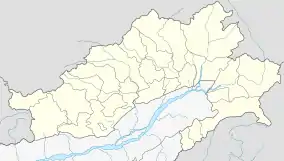 Yingkiong Location in Arunachal Pradesh, India 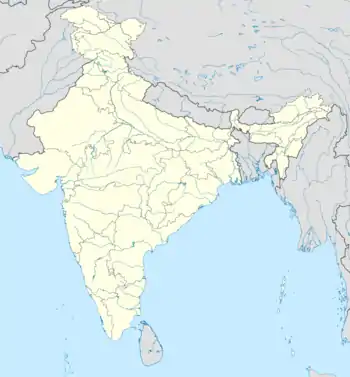 Yingkiong Yingkiong (India) | |
| Coordinates: 28.61037°N 95.047531°E | |
| Country | |
| State | Arunachal Pradesh |
| Elevation | 200 m (700 ft) |
| Population (2011 Census) | |
| • Total | 8,573 |
| Time zone | UTC+5:30 (IST) |
| Vehicle registration | AR-14 |
| Website | https://uppersiang.nic.in/ |
History
The district of Upper Siang (where Yingkiong is located) was a division of the East Siang district until 1995, when it split from East Siang district as a separate administrative district North-west of Pasighat.[5] The administrative district Upper Siang dates back to the period when Arunachal Pradesh was a region independent of British occupation.[6] The region was not brought under administrative control of the British or other powers until the Anglo-Burmese war of 1826-1861.Post the Anglo-Burmese war followed by signing of Treaty of Yandaboo between Burma and the British expeditionary forces, Burma ceded the North-Eastern region of Assam,[7] Cachar, and Manipur,[8] to the British.[9] However, the British control had not extended to the state of Arunachal Pradesh as a whole, as the British only annexed land up to Pasighat in the East Siang, Arunachal Pradesh. In 1911, post the Anglo-Abor wars, the British gained administrative control of Upper Siang. It fell under the administrative control of the Assistant Political Officer stationed at Sadiya in Assam during the period. Some prominent Assistant Political Officer are Francis Jack Needham, who was appointed in 1882,[10] and Noel Williamson, who was assassinated by locals of Komsing village in East Siang district.[11][12]

Geography
The topography of Yingkiong is characterised by hilly terrains and river valleys.[13] The town is located at coordinates 28.61037°N 95.047531°E, and sits at an elevation of 200 m (660 ft) above sea level. To Yingkiong's west flows the Siang River. The Siang is known as Yarlung Zangbo (Tsangpo) in Tibet and as Brahmaputra River in Assam region.[14] The River Siang has Tibet to its north, the Dibang Valley to its east, the West Siang district to its west, and the East Siang district to its south.[15] Yingkiong is surrounded by hills, and the Siang River flows on its west. Tuting, Singging, and Bishing towns lie north of Yingkiong geographically close to Indo-China border. Simong, Gobuk, Puging, Pangkang, Gette, Moying, Bomdo, Likor, and Millang, are some villages and hamlets that surround Yingkiong, among others.
Climate
Yingkiong has a relatively warm and humid subtropical climate. The highest recorded temperature in Yingkiong is 39 °C during summer, and 4 °C in winter.[16] The highest recorded annual rainfall of Yingkiong is 3116 mm.[17] The upper parts of the city receives snowfall for most of the year.
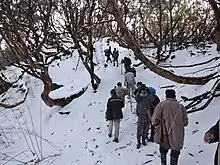
Economy
The majority of Yingkiong households practices farming for basic livelihood,along with it fruits and vegetable cultivation are common for commercial purpose which is endorsed by local administration through MIDH (Mission For Integrated Development of Horticulture) a centrally sponsored scheme of Ministry of Agriculture and Farmers Welfare,Government of India.[18][19] Of the gross 69 percent of households engaged in agriculture in Upper Siang, Yingkiong township has the highest number of urban agrarian households.[16] Jhum cultivation (slash and burn) and terrace farming are the most common farming techniques. Rice, maize and millet are the main food crops. Cash crops like turmeric and sugarcane are commonly grown.[20] Along with agricultural products, handicrafts such as woven bamboo stools known as "Murha" are commonplace at the market. Cultivation of seasonal fruits like oranges and pineapple are common, and during periods of favourable cultivation and surplus output, they are bulk transported for sale in local markets or outside the town in Pasighat. Pisciculture (Fish farming) is also common and it is promoted under centrally sponsored FFDA (Fish Farmer Development Agency) programme to generate employment for locals and revenue for the State.[21] The Adi tribe are remarked as skillful in making a distinct type of traditional basket called 'Egin'. It is used frequently by the locals for carrying household items like rice,dried woods and host of other edibles and farm produces.[22] A variety of Black and Red Tea called Siang Tea[23] are also produced at Deki Tea estate at Ramsing Village for export and domestic consumption.[24]
Demographics
As of the 2011 census of the Government of India, the town has a total population of 8,573 people. The male population was 4,381 and the female population 4,192, with 1,139 persons in the age group of 0 to 6. The total working population was 3,787 persons, with the male working population at 2,221 and the female working population at 1,566.[25] The literacy rate of the region is 64%. The female literacy rate is 44.89% and the male literacy rate is 55%.[26] It has a non-working population of 4,786 persons, mostly of dependent age. Adi is the major dialect spoken in the area. The Hindi language is commonly used as a Lingua franca to communicate with people of diverse speech or with people who do not speak Adi.
Religion
The following table shows the population by religion, according to the 2001 census.
| Total Population | Hinduism | Islam | Christianity | Sikhism | Buddhist | Jain | Donyi-Polo | Not Stated | |
| Total Population | 6,540 | 2,028 | 198 | 1,061 | 4 | 117 | 0 | 3,075 | 57 |
Culture
Festivals
The locals of Yingkiong celebrate the Solung,[27] Aran (Unying-Aran), and Etor,[28] Siang River Darshan and Mopin festivals.
- Solung festival is celebrated for agriculture and good harvest, prevalent among the Adi community are various myths, stories, faiths and beliefs about the origin of the Solung festivity. Generally celebrated mid August–September, the date for the festival is fixed by the village council called 'Kebang'.[16] Sometimes, the 'Gam' (village headman) fixes the date in consultation with other leaders of the village. On the day, villagers prepare rice-beer ('Apong'). Fresh vegetables and plenty of meats are also stored for the occasion.
 Tapu ( a typical aggressive posturing by male members of Adi tribe ) during Aran festival staging the war cry dance during actual tribe wars done as a 'warm up' before the real armed conflict.
Tapu ( a typical aggressive posturing by male members of Adi tribe ) during Aran festival staging the war cry dance during actual tribe wars done as a 'warm up' before the real armed conflict. - Aran (Unying Aran) is a new year festival of the Adi community celebrated in the districts of East and Upper Siang.[29] It marks the arrival of the spring season. During the festival, male elders of the village perform the Bari dance, and young boys and girls performs the Yakjong dance. The dances narrate the stories of the origin of the festival, and they also pray for good health and prosperity of the people.
- Etor festival is celebrated on May 15 by Adi tribes of East and Upper Siang. Etor literally means 'fence' since it is related to protection of crops by fencing cultivated lands and earlier local bovine (Mithuns) were kept protected using fencing in large fields.[30] Huge feast and offerings are made to gods and is celebrated to begin the annual agricultural cycle of the community[28]
- Siang River festival, previously known as the Brahmaputra Darshan Festival, was later rechristened Siang River Festival. After 2005, Yingkiong, Tuting, and Pasighat were chosen as the places to conduct this festival of Communal Harmony.[31]
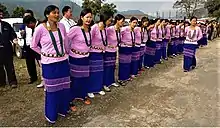 Tribal women performing traditional welcome dance (Ponung) as a part of Siang River festival.
Tribal women performing traditional welcome dance (Ponung) as a part of Siang River festival.
Connectivity
The town is connected to the rest of the country and Arunachal Pradesh via National Highway 513 (NH-513) and NH-52 from Pasighat to Itanagar. Modes of transport include sumo (taxi) services and APSTs (Arunachal Pradesh State Transport) bus services. There is no direct aerial connectivity and an earlier one was limited to Mohanbari Airport in Dibrugarh.[32][33] In 2018, a newly built airport was operationalised in Pasighat town,[34] which is currently the nearest airport to reach Yingkiong. Helicopter services are available from Pasighat, Itanagar and from Assam to reach the town.[35] There are two heliports in the town, one near Siang and the other opposite of the District Collector office in Yingkiong that facilitates helicopter landing services.[36] The nearest railway station is in Murkongselek in the Jonai District of Assam[37] to connect Yingkiong town via Pasighat.[38]
Tourism
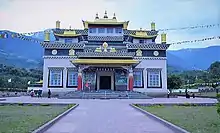

Notable tourist spots in and around the town:
- Jengging-Yingkiong Circuit — a small town and trekking site, situated at a distance of approximately 20 km (12 mi).
- Mouling National Park — created in 1982, the park has abundant flora and fauna including red panda, hoolock gibbons, tigers, wild water buffalo, panther, elephant, hog deer, barking deer, sambar deer, and python.[39]
- Palyul Gompa — a sacred Buddhist temple, located in Tuting,[40] roughly 300 km (190 mi) from Yingkiong towards the North.[41]
- Tuting-Geling Singha Triangle — the 'Pemako Zone' of the Tibetan form of Buddhism;[42] it lies amidst natural lakes,close to the Indo-China border.
- Gandhi Bridge — a hanging bridge over river Siang,[43] made of cane[44] and timber, on the way to Tuting and Moying.
- Ekodumbeng-Ruitala — a region famous for tuber-root like poisonous aconite used for hunting game; animals sighted here include the Gnu goat, musk deer, and various bird species.[45] This place also hold religious significance for followers of Buddhism as these region is also called Riu Tala-(Amlokeshwara) meaning a Paradise.[46][47]
- Mariyang-Pekimodi — home to native tribes of Upper Siang called Pasi, Padam, Dalbing, Millang at a distance of 50 km (31 mi) southeast of Yingkiong is the small town of Mariyang, situated at the confluence of the Yammeng and Yamne rivers. Damroh village (located here) is the largest village in the Upper Siang district.[45] This region is known for sightings of aircraft wreckage of United States lost in 1944 during the Second World War.[48][49]
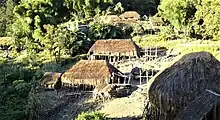 Pekimodi Village near Mariyang town largely untouched by modern development projects.
Pekimodi Village near Mariyang town largely untouched by modern development projects. - Tsitapuri Circuit — pilgrimage site amidst serene lakes and mountains, covered with snows throughout the year.[50] It is considered as one of the dwelling abode of Holy Guru Rinpoche .It has around 108 lakes.Lake Dhankosa is the most well known among them.[51] Followers of Buddhism hold popular belief that here anyone with pure heart witness different sacred wild animals.[52]
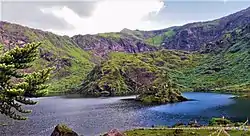 View of sacred Tsitapuri Lake in Upper Siang
View of sacred Tsitapuri Lake in Upper Siang - Nay Dewakota- The word Dewakota translate to 'Abode of God' Nay means the 'Sacred Site' this place is nestled in a plateau flanked by Nyigong river approximately 40 kilometres ahead of Tuting Village in Upper Siang and owing to rough terrain this region is not accessible by motor vehicles.[52] It is believed by devotees of Buddhism that in this sacred pilgrimage site Holy Guru Rinpoche has treasured holy scripts and sacred items yet to be discovered and deciphered,the place also houses numerous caves considered holy by Buddhist locals.[53]
Covid-19
The town has so far reported multiple confirmed cases of covid-19 infections among them was a student returnee from National Capital Region and another reported one is Health and Family Welfare Minister of Arunachal Pradesh who is a native of Yingkiong.The town has no covid-19 testing lab facility so far .[54][55]
Notable people
- Gegong Apang — served as Chief Minister of Arunachal Pradesh for 22 years, making him the longest serving Chief Minister of Arunachal Pradesh.[56] He is also the third-longest serving Chief Minister in India after Pawan Kumar Chamling of Sikkim[57] and Jyoti Basu of West Bengal as of 2021.[58][59]
- Alo Libang — Minister, Health & Family Welfare, Social Welfare, Women & Child Development, Social Justice, Empowerment & Tribal Affairs.[60]
- Apur Bitin — IPS (Indian Police Service) DIGP, Central Range, Arunachal Pradesh.[61]
- Kishon Tekseng — Everest mountaineer.[62]
- Bani Danggen — author.[63][64]
See also
References
- "Upper Siang | Arunachal Pradesh | DISTRICTS OF INDIA". districts.nic.in. Retrieved 19 September 2018.
- http://dcmsme.gov.in/dips/Dist-Profile-Upper-Siang.pdf
- "Unnamed Road to Unnamed Road". Unnamed Road to Unnamed Road. Retrieved 14 June 2019.
- 2011, Yingkiong. "Census, Govt of India".CS1 maint: numeric names: authors list (link)
- "Pasighat to Yingkiong". Pasighat to Yingkiong. Retrieved 22 August 2020.
- "History | DISTRICT UPPER SIANG | India". Retrieved 22 August 2020.
- "LEST WE FORGET: The Burmese Invasions of Assam (1817-1826)". TNT-The NorthEast Today. Retrieved 11 April 2019.
- "RCILTS, IIT Guwahati". www.iitg.ac.in. Retrieved 11 April 2019.
- http://www.ide.go.jp/library/English/Publish/Download/Jrp/pdf/133_5.pdf
- Report on the Administration of North East India. Mittal Publications. 1984.
- "Forgotten fighter of Arunachal - Work on promised memorial yet to begin". www.telegraphindia.com. Retrieved 26 June 2019.
- "Northeast India's 5 unforgettable freedom fighters". TNT-The NorthEast Today. Retrieved 26 June 2019.
- "Ground Water Information Booklet. Upper Siang District, Arunachal Pradesh" (PDF). September 2013.
- "Brahmaputra/Yarlung Tsangpo". International Rivers. Retrieved 19 September 2018.
- "About District". District Upper Siang, Government of Arunachal Pradesh. Retrieved 19 September 2018.
- http://cgwb.gov.in/District_Profile/Arunachal/UPPER%20SIANG.pdf
- Managing natural resources : focus on land and water : felicitation volume in honour of Professor R.L. Dwivedi. Dwivedi, R. L., 1924-, Misra, H. N. (Harikesh N.), 1945-. Delhi. 13 March 2014. ISBN 9788120349339. OCLC 893309586.CS1 maint: others (link)
- "Horticulture | DISTRICT UPPER SIANG | India". Retrieved 11 October 2020.
- "Home | Mission for Integrated Development of Horticulture (MIDH)". midh.gov.in. Retrieved 11 October 2020.
- "ARUNACHAL PRADESH | Department of Agriculture Cooperation & Farmers Welfare | Mo A&FW | GoI". agricoop.nic.in. Retrieved 13 February 2019.
- "Department of Fisheries | Arunachal Pradesh". meenarun.nic.in. Retrieved 13 February 2019.
- Sharma, Tika Prasad (October 2008). "Ethnobotanical observations on Bamboos among Adi tribes in Arunachal Pradesh". Indian Journal of Traditional Knowledge. 7 (4): 594–597 – via Department of Botany, Gauhati University, Guwahati 781014, Assam.
- "SIANG TEA AND INDUSTRIES PVT LTD - Company, directors and contact details | Zauba Corp". www.zaubacorp.com. Retrieved 19 September 2018.
- http://www.mospi.gov.in/sites/default/files/6ec_dirEst/ec6_Arunachal%20Pradesh.pdf
- "Census of India: Primary Census Abstract". censusindia.gov.in. Retrieved 19 September 2018.
- "Census of India: Search Details". censusindia.gov.in. Retrieved 9 June 2019.
- "CS visits Upper Siang, attends Solung festival". The Arunachal Times. Retrieved 19 September 2018.
- Mishra, B.P.; Kumawat, M.M.; Kumar, Naresh; Riba, Toge; Kumar, Sanjeev (2016). "Significance of Aran Festival for Rodent Management by Adi Tribes of Arunachal Pradesh". Journal of Global Communication. 9 (1): 15. doi:10.5958/0976-2442.2016.00004.5. ISSN 0974-0600.
- "Unying Aran celebrated with traditional fervor". Arunachal Times. Retrieved 19 September 2018.
- Pathak, Guptajit; Gogoi, Raju (2008). Cultural fiesta in the "Island of peace" Arunachal Pradesh. New Delhi, India: Mittal Publications. ISBN 978-8183242318. OCLC 277280040.
- "Famous Festivals Of Arunachal Pradesh". Nelive. 4 July 2018. Retrieved 19 September 2018.
- "Dibrugarh Airport to Yingkiong". Dibrugarh Airport to Yingkiong. Retrieved 9 June 2019.
- "AAI sees potential in Dibrugarh airport". www.telegraphindia.com. Retrieved 9 June 2019.
- "Arunachal's first commercial flight lands at Pasighat airport - Times of India". The Times of India. Retrieved 19 September 2018.
- "Civil Aviation – Government of Arunachal Pradesh". www.arunachalpradesh.gov.in. Retrieved 19 September 2018.
- "Helipad Yingkiong". Helipad Yingkiong. Retrieved 9 June 2019.
- Shah, Jay. "Murkongselek Station - 3 Train Departures NFR/Northeast Frontier Zone - Railway Enquiry". indiarailinfo.com. Retrieved 20 September 2018.
- Trade, TI. "The Assam Tribune Online". www.assamtribune.com. Retrieved 20 September 2018.
- "Mouling National Park - complete detail". NatureConservation.in. 12 September 2018. Retrieved 19 September 2018.
- Census of India 2011. Arunachal Pradesh. District Census Handbook. Upper Siang. Village and Town Directory (PDF). Directorate of Census Operations, Arunachal Pradesh. 2011. p. vii.
- Roy, Sushobhan. "Tuting". Times of India Travel. Retrieved 19 September 2018.
- "Pasighat-Jengging-Yingkiong-Tuting". Arunachal Tourism. Retrieved 2 December 2019.
- "Gandhi Bridge speeded up to become functional soon". Arunachal Observer. 23 November 2017. Retrieved 20 September 2018.
- "Governor on Gandhi Bridge". The Governor of Arunachal Pradesh. Retrieved 20 September 2018.
- "Places of Interest". District Upper Siang, Government of Arunachal Pradesh. Retrieved 18 March 2019.
- "Yangsang Pemako". Arunachal Tours. Retrieved 18 March 2019.
- "Ruitala Trek, Arunachal Pradesh". My North East India. Retrieved 18 March 2019.
- Unnithan, Sandeep (25 October 2008). "US military team in Arunachal Pradesh to investigate WWII wreckage". India Today. Retrieved 18 March 2019.
- "More World War II Remains Found In Arunachal Pradesh". HuffPost India. 21 December 2016. Retrieved 18 March 2019.
- "Tuting". Explore The Unexplored. Retrieved 18 March 2019.
- http://www.bhutanstudies.org.bt/publicationFiles/JBS/JBS_Vol34/6.The%20Founder%20of%20Lamaism%20in%20Tibet.pdf
- "Places of Interest | DISTRICT UPPER SIANG | India". Retrieved 12 October 2020.
- "Can a Mystical Valley in Arunachal Pradesh Offer Enlightenment?". Natgeotraveller. Retrieved 12 October 2020.
- "Arunachal Pradesh reports fourth COVID-19 case". Deccan Herald. 31 May 2020. Retrieved 15 September 2020.
- Desk, Sentinel Digital (15 September 2020). "Arunachal Health & Family Welfare Minister Alo Libang tests COVID positive - Sentinelassam". www.sentinelassam.com. Retrieved 15 September 2020.
- "Congress leader Gegong Apang joins BJP". The Hindu. PTI. 20 February 2014. ISSN 0971-751X. Retrieved 20 September 2018.CS1 maint: others (link)
- Desk, The Hindu Net (29 April 2018). "Pawan Kumar Chamling crosses Jyoti Basu's record as longest-serving Chief Minister". The Hindu. ISSN 0971-751X. Retrieved 20 September 2018.
- "Top 5 longest serving Chief Ministers in India". Jagran Post. Retrieved 20 September 2018.
- Apr 30, TIMESOFINDIA COM | Updated; 2018; Ist, 16:11. "India's longest-serving CMs | India News - Times of India". The Times of India. Retrieved 11 June 2019.CS1 maint: numeric names: authors list (link)
- "Cabinet Ministers". Arunachal Pradesh, Official State Portal. Retrieved 11 June 2019.
- "Recipient of Police Medal || Arunachal Pradesh Police". arunpol.nic.in. Retrieved 11 June 2019.
- "Arunachal duo conquers Everest without Sherpas - Times of India". The Times of India. Retrieved 1 January 2019.
- Danggen, Bani (2003). The kebang : a unique indigenous political institution of the Adis (1st ed.). Delhi : Himalayan Publishers ; Itanagar : Sole distributers, B.D. Dist[r]ibuters & Book Sellers.
- "9788190372602: A Comparative Study of Bon Religion of Ancient Tibet with Donyi Polo Faith of the Adis of Arunachal Pradesh - AbeBooks - Bani Danggen: 8190372602". www.abebooks.com. Retrieved 26 April 2019.